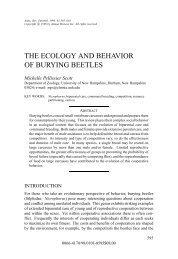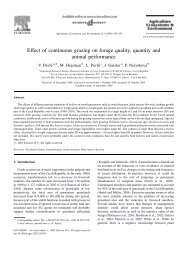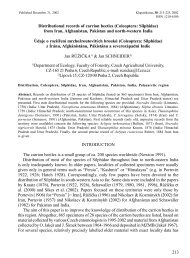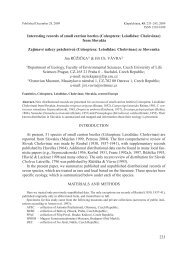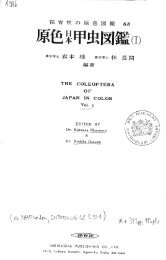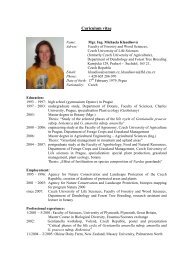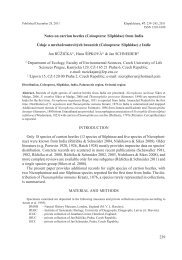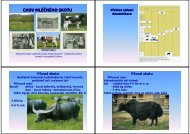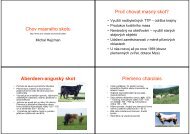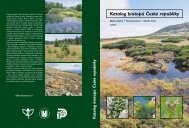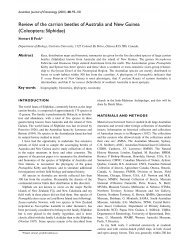- Page 7 and 8:
HistoryLinnaeus named two species o
- Page 10 and 11:
ZOOTAXA65nomina nuda, misspellings,
- Page 12 and 13:
ZOOTAXA65AcknowledgementsThis proje
- Page 14 and 15:
ZOOTAXA65Available species group na
- Page 18 and 19:
ZOOTAXA peruvianus Pic, 1917; as va
- Page 20 and 21:
ZOOTAXA plagiatipennis Lewis, 1879;
- Page 22 and 23:
ZOOTAXA 1790 Olivier: no. 10, p. 6
- Page 24 and 25:
ZOOTAXA 1989 Kozol: 1-10 (biology,
- Page 26 and 27:
ZOOTAXA 1868 Gemminger & Harold: 71
- Page 28 and 29:
ZOOTAXA 1970 Franz: 213 (checklist,
- Page 30 and 31:
ZOOTAXA 1933 Semenov-Tian-Shanskij:
- Page 32 and 33:
ZOOTAXA 1895b Reitter: 326 (descrip
- Page 34 and 35:
ZOOTAXA 1986 Anderson & Peck: 283 (
- Page 36 and 37:
ZOOTAXA65Florida. The melanic popul
- Page 38 and 39:
ZOOTAXA 1986 Cho & Lee: 20 (phyloge
- Page 40 and 41:
ZOOTAXA65N. confusus and N. sepulto
- Page 42 and 43:
ZOOTAXA 1884 Marseul: 185 (key, des
- Page 44 and 45:
ZOOTAXA 1990 Peck: 1123 (key)651990
- Page 46 and 47:
ZOOTAXA 1870 Motschulsky: 352 (desc
- Page 48 and 49:
ZOOTAXA = flexuosus Portevin,192465
- Page 50 and 51:
ZOOTAXA 1761 Sulzer: pl. 2, fig. 10
- Page 52 and 53:
ZOOTAXA 1889 Fowler: 43 (descriptio
- Page 54 and 55:
ZOOTAXA 1983 Putman: 38-42 (biology
- Page 56 and 57:
ZOOTAXA 2002 Nikolajev & Kozminykh:
- Page 58 and 59:
ZOOTAXA 1895b Reitter: 324 (descrip
- Page 60 and 61:
ZOOTAXA 1884 Marseul: 184 (key, des
- Page 62 and 63:
ZOOTAXA 1930 Roubal: 240 (catalog i
- Page 64 and 65: ZOOTAXA 1910 Barkowski: 80 (key, de
- Page 66 and 67: ZOOTAXA 1928 Hatch: 130 (catalog)65
- Page 68 and 69: ZOOTAXA 1870 Vollenhoven et al.: 54
- Page 70 and 71: ZOOTAXA 1939 Lengerken: 263 (biolog
- Page 72 and 73: ZOOTAXA 1986 Nishikawa: 99 (catalog
- Page 74 and 75: ZOOTAXA 1909 Bickhardt: 75 (descrip
- Page 76 and 77: ZOOTAXA Nicrophorus hybridus Hatch
- Page 78 and 79: ZOOTAXA65“PARALECTOTYPE Nicrophor
- Page 80 and 81: ZOOTAXA 1944 Arnett: 7 (morphology:
- Page 82 and 83: ZOOTAXA 1882 Gradl: 331 (descriptio
- Page 84 and 85: ZOOTAXA 1993b Kozminykh: 65 (key, d
- Page 86 and 87: ZOOTAXA 1965b Roussel: 6452 (morpho
- Page 88 and 89: ZOOTAXA 1926a Portevin: 257 (revisi
- Page 90 and 91: ZOOTAXA = pasqueti Pic, 1917 NEW ST
- Page 92 and 93: ZOOTAXA65Lectotype data for Nicroph
- Page 94 and 95: ZOOTAXA 1891 Heyden et al.: 138 (ch
- Page 96 and 97: ZOOTAXA 1971 Freude: 194 (key in Ge
- Page 98 and 99: ZOOTAXA 1995 Kozminykh: 110 (key in
- Page 100 and 101: ZOOTAXA65Type depository: MCZC: Cam
- Page 102 and 103: ZOOTAXA 1868 Gemminger & Harold: 71
- Page 104 and 105: ZOOTAXA 1925 Winkler: 264 (catalog)
- Page 106 and 107: ZOOTAXA65Type depository: MZHF: Hel
- Page 108 and 109: ZOOTAXA 1866 Marseul: 38 (catalog i
- Page 110 and 111: ZOOTAXA 1926a Portevin: 222 (revisi
- Page 112 and 113: ZOOTAXA 1866 Michow: 411 (descripti
- Page 116 and 117: ZOOTAXA65from reduced to absent, bu
- Page 118 and 119: ZOOTAXA Paralectotype data “17/67
- Page 120 and 121: ZOOTAXA Nicrophorus maculifrons Kra
- Page 122 and 123: ZOOTAXA 1955b Nakane: 54 (key, desc
- Page 124 and 125: ZOOTAXA 1911 Wickham: 10 (checklist
- Page 126 and 127: ZOOTAXA 2000 Sikes & Peck: 395 (des
- Page 128 and 129: ZOOTAXA65with the elytral fascia sh
- Page 130 and 131: ZOOTAXA 1975a Emetz: 60 (checklist
- Page 132 and 133: ZOOTAXA65border “LECTOTYPE Nicrop
- Page 134 and 135: ZOOTAXA 1992 Kozminykh: 64 (checkli
- Page 136 and 137: ZOOTAXA 1879 Dohrn: 459 (comment in
- Page 138 and 139: ZOOTAXA Nicrophorus nigricornis Fal
- Page 140 and 141: ZOOTAXA 1920 Leng: 86 (catalog) >>
- Page 142 and 143: ZOOTAXA 1925 Winkler: 264 (catalog)
- Page 144 and 145: ZOOTAXA65Type depository: BMNH: Lon
- Page 146 and 147: ZOOTAXA 1933 Wolcott & Montgomery:
- Page 148 and 149: ZOOTAXA 1994 Beninger: 135-143 (bio
- Page 150 and 151: ZOOTAXA Nicrophorus podagricus Port
- Page 152 and 153: ZOOTAXA 1999 Háva et al.: 76 (key,
- Page 154 and 155: ZOOTAXA 1982c Anderson: 1316 (biolo
- Page 156 and 157: ZOOTAXA Nicrophorus quadraticollis
- Page 158 and 159: ZOOTAXA 1933 Semenov-Tian-Shanskij:
- Page 160 and 161: ZOOTAXA 1994a Ôhara: 58 (checklist
- Page 162 and 163: ZOOTAXA 1895b Reitter: 324 (descrip
- Page 164 and 165:
ZOOTAXA 1985 Peck & Anderson: 287 (
- Page 166 and 167:
ZOOTAXA Nicrophorus scrutator Blanc
- Page 168 and 169:
ZOOTAXA 1859 Schaum: 36 (catalog in
- Page 170 and 171:
ZOOTAXA 1849 Bach: 153 (checklist,
- Page 172 and 173:
ZOOTAXA 1980 Franssen: 46 (morpholo
- Page 174 and 175:
ZOOTAXA 1887 Lewis: 341 (descriptio
- Page 176 and 177:
ZOOTAXA65139.48°E,]19-24 August 18
- Page 178 and 179:
ZOOTAXA 1970 Gersdorf: 366 (morphol
- Page 180 and 181:
ZOOTAXA 1998b Scott: 598+ (biology,
- Page 182 and 183:
ZOOTAXA 1944 Arnett: 5 (morphology:
- Page 184 and 185:
ZOOTAXA 1761 Rösel von Rosenhof: 2
- Page 186 and 187:
ZOOTAXA 1873 Klika: 127 (checklist
- Page 188 and 189:
ZOOTAXA 1939 Székessy: 943 (morpho
- Page 190 and 191:
ZOOTAXA 1987 Jensen: 116 (biology,
- Page 192 and 193:
ZOOTAXA 1881 Westhoff: 108 (descrip
- Page 194 and 195:
ZOOTAXA65Type depository: LNMD: Mü
- Page 196 and 197:
ZOOTAXA 1888 Seidlitz: 313 (key in
- Page 198 and 199:
ZOOTAXA 1948 Clark: 27 (checklist)6
- Page 200 and 201:
ZOOTAXA 1982 Wisiniewski (biology,
- Page 202 and 203:
ZOOTAXA 1993 RÉÓigka: 34 (checkli
- Page 204 and 205:
ZOOTAXA = aurora Motschulsky, 1860
- Page 206 and 207:
ZOOTAXA 1937 Leech: 156 (nomenclatu
- Page 208 and 209:
ZOOTAXA 1885 Marseul: 169 (catalog
- Page 210 and 211:
ZOOTAXA 1937 Leech: 156 (nomenclatu
- Page 212 and 213:
ZOOTAXA Nicrophorus vestigator Hers
- Page 214 and 215:
ZOOTAXA 1922 Sherborn: 6882 (catalo
- Page 216 and 217:
ZOOTAXA65Spanish)2002 Nikolajev & K
- Page 218 and 219:
ZOOTAXA 1902 Heyden: 12 (nomenclatu
- Page 220 and 221:
ZOOTAXA = olfactor Gistel, 1848 NEW
- Page 222 and 223:
ZOOTAXA PTOMASCOPUS Kraatz, 1876: 3
- Page 224 and 225:
ZOOTAXA65Type depository: BMNH: Lon
- Page 226 and 227:
ZOOTAXA 1925 Winkler: 265 (catalog)
- Page 228 and 229:
ZOOTAXA Ptomascopus zhangla Háva,
- Page 230 and 231:
ZOOTAXA65ReferencesAbbott, C.E. (19
- Page 232 and 233:
ZOOTAXA65nepalensis are more closel
- Page 234 and 235:
ZOOTAXA65Bedick, J.C. (1997) Distri
- Page 236 and 237:
ZOOTAXA65Blanchard, É. (1842) Inse
- Page 238 and 239:
ZOOTAXA65description of N. didymus.
- Page 240 and 241:
ZOOTAXA65Conley, M.R. (1982) Carrio
- Page 242 and 243:
65ZOOTAXA Delahon, P. (1913) Nachtr
- Page 244 and 245:
ZOOTAXA65Eisfelder, I. (1963) Käfe
- Page 246 and 247:
ZOOTAXA65Faldermann, F. (1835a) Add
- Page 248 and 249:
ZOOTAXA65Gaubil, J. (1849) Catalogu
- Page 250 and 251:
ZOOTAXA65Gwiazdowicz, D.J. (2000) M
- Page 252 and 253:
ZOOTAXA65Hausmann, J.F.L. (1799) En
- Page 254 and 255:
ZOOTAXA65Hlisnikovsky, J. (1942) Co
- Page 256 and 257:
ZOOTAXA65Jakovlev, B.E. (1887) Col
- Page 258 and 259:
ZOOTAXA65Kirby, W. & Spence, W. (18
- Page 260 and 261:
ZOOTAXA65Kozminykh, V.O. (1997) Fau
- Page 262 and 263:
ZOOTAXA65Labitte, A. (1916) Longév
- Page 264 and 265:
ZOOTAXA65Lindroth, C.H. & Ball, G.E
- Page 266 and 267:
65ZOOTAXA Marseul, S.-A. (1866) Cat
- Page 268 and 269:
ZOOTAXA65Miller, S.E. & Miller, P.M
- Page 270 and 271:
ZOOTAXA65Müller, J.K. & Dressel, J
- Page 272 and 273:
ZOOTAXA65Newman, E. (1838) Entomolo
- Page 274 and 275:
ZOOTAXA65Opler, P.A. [ed.] (1985) S
- Page 276 and 277:
ZOOTAXA65Peck, S.B. & Miller, S.E.
- Page 278 and 279:
ZOOTAXA65Portevin, G. (1914a) Silph
- Page 280 and 281:
ZOOTAXA65Ranson, J. (1864) Fecundit
- Page 282 and 283:
ZOOTAXA65Riha, P. (1949) Nova odchy
- Page 284 and 285:
ZOOTAXA65RÉÓigka, J. (1999) Beetl
- Page 286 and 287:
ZOOTAXA65Schneider, P. (1978) Die F
- Page 288 and 289:
ZOOTAXA65Schweitzer, D.F. & Master,
- Page 290 and 291:
65ZOOTAXA (revision: key, descripti
- Page 292 and 293:
ZOOTAXA65Smith, R.J., Hines, A., Ri
- Page 294 and 295:
ZOOTAXA65Stroud, C.P. (1950) A surv
- Page 296 and 297:
ZOOTAXA65Trumbo, S.T. (1990b) Repro
- Page 298 and 299:
ZOOTAXA65Walkden, H.H. (1944) Insec
- Page 300 and 301:
ZOOTAXA65Xambeu, P. (1892) Moeurs e
- Page 302 and 303:
ZOOTAXA65Index (continued)Nicrophor
- Page 304:
ZOOTAXA65Index (continued)Nicrophor



